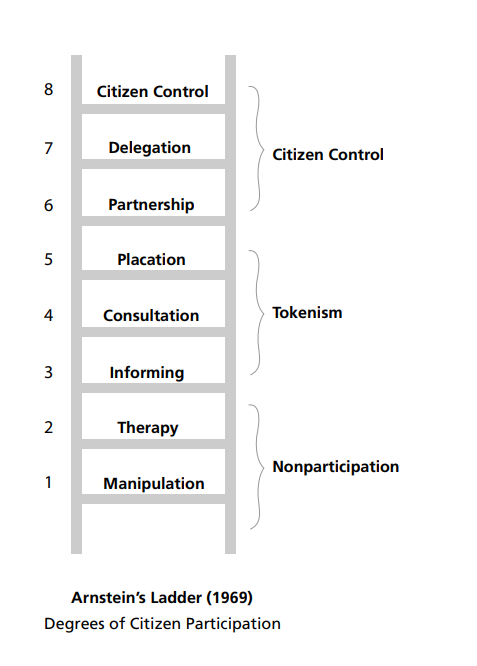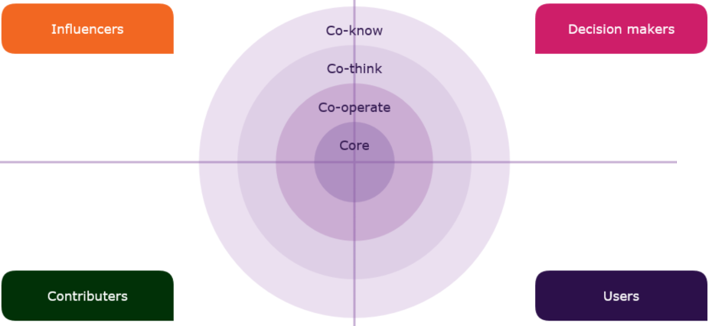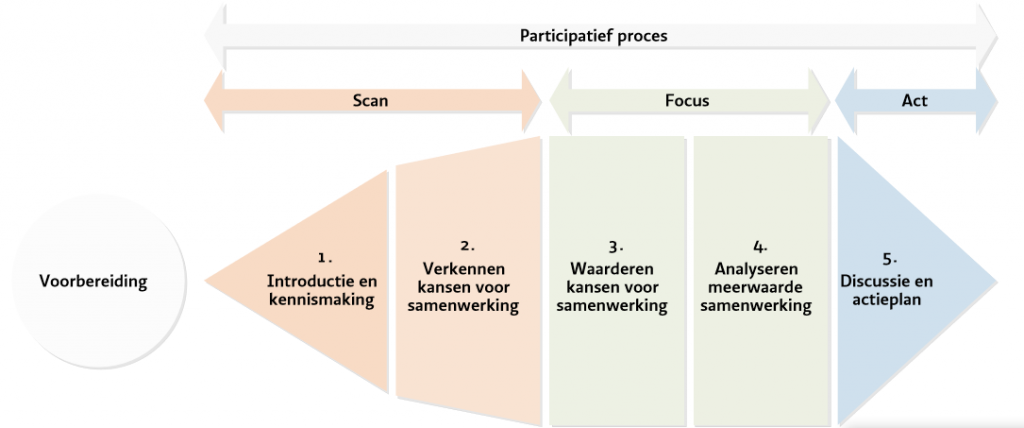Guidance: stakeholder participation and coalition building
Organising stakeholder participation: which stakeholders to include?
In participation processes, a large number of stakeholders can be present. Not all stakeholders have the same attitude towards the project, nor are they all of the same importance to its success (see stakeholder analysis). The main objective is to include those stakeholders that contribute to successful project implementation and are necessary to form the crucial coalition. BwN requires more than just engagement, it also requires cooperation among stakeholders. The stakeholder analyses can serve as a basis to select specific stakeholders to actively involve. The level of involvement can be aligned with the level of interest and influence (e.g. Power-Interest Matrix) or urgency, power and legitimacy (e.g. salience model).
Here we introduce two frameworks to assess the suitable type of involvement for different stakeholders. Arnstein (1969) developed the Ladder of Citizen Participation for stakeholder management and engagement. This Ladder has been widely used and also adapted for different situations using different terms, but communicating the same message: there are different levels of participation possible, from non-participation, towards low- and high participation leading finally to co-decision making (Basco-Carrera et al., 2017).

Alternatively, with the Bull’s Eye tool the desired level of participation for each of the stakeholders can be determined. This matrix distinguishes between influencers, decision makers, contributes and users. These stakeholders are positioned in the matrix, in which various rings indicate the degree of participation. The core group is involved most closely, whereas the co-knowers are only informed.

Organizing stakeholder engagement
A range of tools is available to involve stakeholders for varying degrees of participation. Before starting stakeholder engagement however, first assess the suitability and feasibility to start engagement. Assess the specific environment, not every context fit’s a stakeholder engagement process. Second, be clear on what is the intended outcome. And third, what do stakeholders expect and are they motivated to contribute to a stakeholder engagement trajectory? If they aren’t, there is a fierce risk of so-called ‘stakeholder fatigue’ (Ottow, 2020) and adjustment of the stakeholder engagement approach is needed.
When stakeholder engagement is feasible and stakeholder are willing to cooperate, stakeholder engagement processes can be planned. Stakeholder engagement is always part of a bigger process and cannot be established in a single meeting. Different types of meetings can be organized for different stakeholder groups. When preparing meetings pay attention to the invitations. Depending on the culture, the type of stakeholders, different type of invitations may be appropriate. In some context giving a call one day prior to the meeting is enough, for other contexts formal letters with appropriate stamps and signatures are needed. When preparing for the meetings, select engagement tools appropriate to the (cultural) context. A range of tools is available including maps, role plays, serious games, field trips and other. It is of essential important to have fun in the meeting.
Stakeholder engagement tool: interactive group modeling or MapTable
The term MapTable refers to both hardware and software that function as a design and decision-support tool. The hardware consists of a large, potable touch-screen design table that can be used as an instrument in spatial planning processes. MapTable software is an umbrella term for software that is suitable for use together with a digital design table. MapTables can be used for interactive design processes with stakeholders, and can assist in visualizing potential problems and solutions.
Stakeholder engagement tool: Visual Thinking
Visual thinking is the process of translating one’s thoughts to relatively simple images on paper. This process has proven to be very useful in assisting the development of concepts, identifying key elements, and synthesizing group ideas. It follows the idea that “an image speaks a thousand words”. This tool description is based on the way a Dutch industrial design company (JAM) puts visual thinking into practice (http://www.jam-site.nl/). Building with Nature has implemented this tool during workshops to translate conceptual designing discussions into conceptual design visualizations. It successfully assisted with clarifying a certain issue at stake, including roles and responsibilities of people involved.
Coalition building
The implementation of BwN measures relies on multiple stakeholders and their resources. In many situations, BwN solutions cannot be realized by a single players as the solutions is multi-purpose and the management and decision-making crosses institutional sectors. In those situations, coalition forming is essential for successful implementation. This section continues by elaborating on the possible ways to form coalitions. Coalitions are the most extreme form of engagement; the coalition is owner of the project and thus the ‘core’ in the Bull’s eye or the top stage of the Ladder.
Coalitions are temporary alliances of stakeholders in which they share risks, costs, benefits and responsibilities of a project or implementation. Coalitions create valuable solutions and stimulate and facilitate knowledge sharing. Forming a coalition is particulary useful in contexts in which powers are scattered among multiple stakeholders as is the case when implementation BwN solutions.
A method to building coalitions is the Added Value of Joint Action (in Dutch: Meerwaarde van Samenwerking) (Janssen et al., 2019). In a participatory process, players investigate what they can achieve together, whether working together provides added value and how they can achieve this. This method shows how a group of players can actively work together to shape cooperation in situations where (more) collaboration is desired. The aim of Added Value of Joint Action is to facilitate cooperation between parties. It builds on the insights from cooperative game theory (see Straffin, 1993). This field provides insight in the value of cooperating among players. Three assumptions are central : (1) multiple parties determine the outcome of a game; (2) players will only cooperation when it contributes to achieving their ambitions, or when they ‘win’, and; (3) players judge a cooperation from their own interest.
The instrument can be applied by going through the preparation phase and five process steps (see figure below). After getting to know each other, the parties visualize the opportunities for cooperation, after which each party appreciates these opportunities by assigning values. Based on the individual values, the added value of collaboration for the group is determined and it is shown how this outcome can be achieved.

